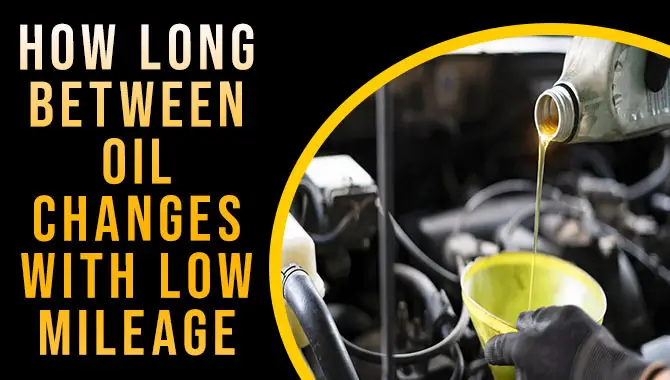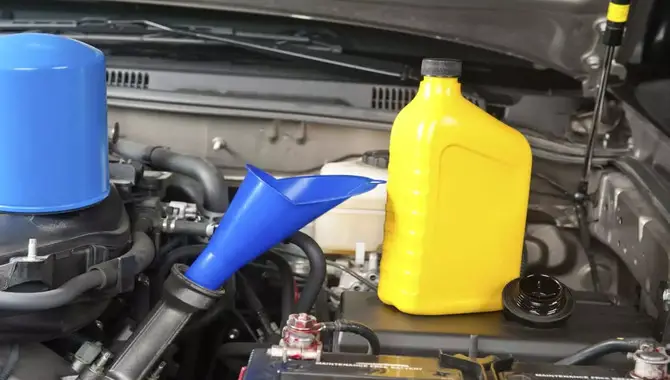A car’s oil is a vital component of the engine. It lubricates moving parts and helps to maintain engine efficiency.
The oil is also handy in lubricating the car’s transmission and other mechanical components. Your car’s oil is like its blood; it keeps everything running smoothly. But what happens when you hardly use your car? Can you still follow the old advice of changing your oil every 3,000 miles? We’ll address many car owners’ important question: how long should you wait between Oil Changes With Low Mileage cars?
We’ll also talk about what you need to know about oil changes, including when to change the oil, how to choose the right oil for your car, and whether you need synthetic oil. Plus, we’ll also show you how to change the oil on a low-mileage car and the benefits of regular oil changes. So, whether you’re a new car owner or have been driving for years, you’ll want to read on.

What Is Low Mileage?

Low mileage is typically defined as driving less than 7500 miles per year. However, this does not necessarily mean your vehicle can go longer between oil changes. The general recommendation for an oil change is every 3000-5000 miles, but with the use of synthetic oil, the interval can increase to up to 10,000 miles.
Factors such as short trips (less than 10 miles), towing, and driving on gravel roads can contribute to the need for a more frequent oil change.
Oil-life monitoring systems are available for newer cars, which notify the driver when an oil change needs. It’s important to reset the oil-life monitoring system after an oil change service performs to ensure accurate tracking for future oil changes.
How Long Between Oil Changes With Low Mileage? Answer

If you are a low mileage driver, you should get an oil change once every 3000-5000 miles or after a year, whichever comes first. However, if you frequently drive off-road or in colder or warmer temperatures. You are considered to be in “severe driving conditions,” Your oil change interval should be cut in half.
Changing your car’s oil every 10,000 miles is generally recommended, but for some newer vehicles with synthetic oil. The time between oil changes can increase to 10,000 miles. On the other hand, if your car is an older model with conventional oil.
It is recommended to stick to oil changes every 3,000 to 5,000 miles. Ultimately, it is important to keep an eye on your car’s oil level and change it regularly to ensure the longevity of your engine.
5 Things To Know About Oil Changes For Your Car

Regular oil changes play a significant role in maintaining a car engine’s performance and health. It is essential to have the oil levels checked regularly and follow the manufacturer’s instructions. However, modern cars’ “every 3,000 miles or every three months” rule is outdated.
And there is no one-size-fits-all answer regarding how often you should change your motor oil. The best approach is to follow the car manufacturer’s recommendations according to your car’s make, model, and year it was built.
This helps to avoid unnecessary oil changes that can add up and save you money over time. In any case, regular oil changes are necessary to replenish the oil in the engine and keep the engine running smoothly.
1.When To Change The Motor Oil

If you’re wondering how often you should change the oil in your car, you should know a few things. The recommended oil change schedule for cars depends on their make, model, and year built. Most car manufacturers recommend an oil change at least once a year, regardless of how many miles you have driven. Generally, oil changes should occur every 7,500 to 10,000 miles or every six to twelve months.
Regular oil changes are important because motor oil helps to cool, clean, and protect the engine and needs to replenish regularly. Failure to change the oil could seriously affect your car’s engine. So, it’s important to keep track of your last oil change and ensure that you change it before it becomes too old and ineffective.
2.How Often To Check The Oil Level

Check your car’s oil level at least once a month or every other gas fill-up. It’s important not to assume that newer cars don’t need oil level monitoring. As they may require topping up between oil changes. If your car has a dipstick, check the oil level when the engine is cool and park the car on level ground.
In addition to checking the oil level regularly, many automakers suggest resetting the oil-life monitoring system when changing the oil. It’s also worth noting that manuals for many cars no longer include “severe service” recommendations, as the oil-life monitoring system adjusts the oil change interval accordingly. Stay on top of your car’s oil changes and regularly check the oil level. You can help ensure your car runs smoothly and lasts as long as possible.
3.How Often To Change The Motor Oil

Regarding oil changes for your car, several important things must remember. Historically, oil changes were recommended every 3,000 miles or every three months. However, many manufacturers now recommend oil changes every 7,500 to 10,000 miles. Some car models may also be compatible with synthetic oil, prolonging the time between changes.
It’s important to note that high-compression engines, auto start and stop technology, and turbocharging. And other automotive technological advances have increased demands on oil and lubricant technology. This means that car owners should always follow the guidance in the car’s owner’s manual regarding how often to change the oil. Car owners can help ensure their vehicles’ longevity and performance by keeping up with regular oil changes.
4.Choosing The Right Oil For Your Car

When it comes to oil changes for your car, there are a few important things that every driver should know. One of the most important is choosing the right oil for your engine. Different types of oils have specific designs for different engines and should be handy accordingly. Check the label on the oil to identify the viscosity rating and other important details about the oil’s composition.
Regular oil changes are also essential to ensure engine efficiency and longevity. Motor oil helps clean, cool, and protect your engine but can degrade and lose effectiveness over time. Conventional motor oil should generally change every 3,000 miles, while synthetic varieties can last up to 10,000 miles. However, specific recommendations may vary depending on the make and model of your car.
It’s also important to consider new engine technologies. As high compression engines, auto start and stop technology, and turbocharging have increased demand for oil and lubricant technology. As such, staying informed on the latest recommendations and advancements in automotive technology is important to ensure you get the most out of your vehicle’s performance.
5.Do You Need Synthetic Oil?

Regarding oil changes for your car, several important things must remember. One of these is the choice between conventional and synthetic oil. Synthetic oil has specific designs to be more effective at resisting breakdown and withstanding high temperatures, making it a popular choice among many drivers.
However, for most drivers, upgrading from conventional oil to synthetic is not worth the cost. While synthetic oil may require warranty coverage on certain vehicles. The average driver doesn’t need to see a significant improvement in performance or engine protection.
That being said, there are certain situations where synthetic oil may be beneficial. For example, if you frequently take short trips or live in an area with extreme temperatures, synthetic oil may help to protect your engine. Ultimately, it is important to consult with a trusted mechanic or follow your vehicle manufacturer’s recommendations to decide on the best type of oil for your car.
How To Make An Oil Change With A Low-Mileage Car

As a car owner, you want to keep your car running smoothly and maintain its overall condition. Regular oil changes are among the most important factors in keeping your car in good shape. For low-mileage cars, many automakers have oil-change intervals at around 7,500 to 10,000 miles and six or 12 months for time.
However, to ensure the most reliable performance for your vehicle. Industry experts recommend an oil change at least once every 3,000 to 5,000 miles of driving. Synthetic oils are generally preferred for their longer lifespan and superior lubrication properties.
Over two years and 30,000 miles, an oil change can cost around $60. While the old rule of thumb for oil changes was every three months or 3,000 miles, following the recommended maintenance schedule provided by your vehicle’s manufacturer will ensure your car remains in optimal condition for the long haul.
How Often Should An Oil Change Do With A Low-Mileage Car?

The general rule for low-mileage cars is to get an oil change every 3,000 miles or every three months, whichever comes first. Additionally, the mileage threshold does not indicate when to change the oil. Underuse is not friendly to engine oil, and the oil ideally should replace every 3000 – 5000 miles, regardless of the number of miles driven.
However, based on specific car manufacturers and their lineups, synthetic oil can stretch oil change intervals up to 10,000 miles. It helps to check your car’s owner’s manual for oil change recommendations specific to your car’s make and model to ensure regular maintenance does correct. It can considerably increase engine life, enhance fuel efficiency, and save repair costs in the long run.
What Are The Benefits Of Having An Oil Change With A Low-Mileage Car?

Low-mileage vehicles should change their oil at recommended intervals of 3000 to 5000 miles to ensure optimal engine performance and maintenance. Synthetic oil can extend the time between oil changes by 10,000 miles.
This can save you money in the long run and offer benefits such as improved performance and reduced strain on the engine. However, since synthetic oil is handy, low-mileage oil changes are typically more expensive than regular oil changes. Luckily, some manufacturers offer oil change specials that can reduce the cost of oil changes. Regardless of the mileage, changing your oil regularly is important to keep your engine running smoothly.
Conclusion
In conclusion, oil changes are important to keeping your car running smoothly, even with low mileage. Determining how often you need an oil change depends on several factors, including the make and model of your car, your driving habits, and the type of oil you use.
To ensure you are giving your car the care it needs, follow the manufacturer’s recommended oil change intervals as a starting point. If you are unsure when your car needs an oil change, consult a professional or refer to their service manual. Regular oil changes can help prolong the lifespan of your car and improve its overall performance.
Frequently Asked Questions
Is It OK To Change The Oil Once A Year With Low Mileage?
It generally recommends changing your car’s oil every 5,000 to 7,500 miles or every six months (whichever comes first), regardless of mileage. However, if you drive your car infrequently (such as less than 6,000 miles per year). You may be able to stretch this time frame to one year.
How Often Should You Change Your Oil If You Don T Hit The Mileage?
Changing your oil every six months is generally recommended, even if you haven’t hit your vehicle’s mileage limit. This is because oil can break down over time, leading to engine problems if it is not changed regularly.
How Long Does Oil Last On Low Mileage?
While low-mileage vehicles may not accumulate as many miles as other cars. Changing the oil at regular intervals of 3000 to 5000 miles or every six months to prevent oil breakdown and ensure optimal engine performance is still recommended. Synthetic oil can extend this timeframe by up to 10,000 miles
How Often Should You Change Your Car’s Oil If You Drive Less Than 1000 Miles Annually?
Even if you don’t drive your car often, changing your oil at least once a year still recommends. This is because oil can still break down over time, even if it isn’t handy frequently. Additionally, some car manufacturers may have specific recommendations for oil changes based on periods rather than mileage, so checking your car’s manual for specific guidance is important.
Do I Need An Oil Change If I Don’t Drive A Lot?
Even if you don’t drive a lot, it is still recommended that you change your car’s oil regularly. While time and mileage are the two main factors determining when an oil change is necessary, neglecting it can lead to a build-up of dirt and debris that can damage your vehicle’s engine.

